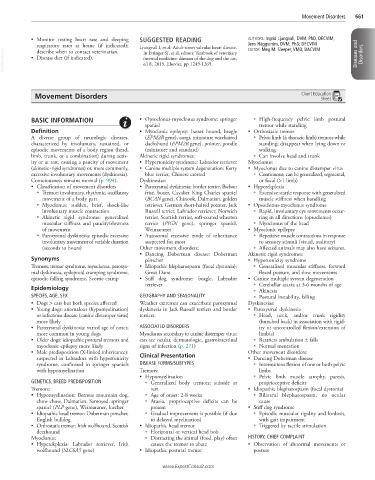Page 1309 - Cote clinical veterinary advisor dogs and cats 4th
P. 1309
Movement Disorders 661
• Monitor resting heart rate and sleeping SUGGESTED READING AUTHORS: Ingrid Ljungvall, DVM, PhD, DECVIM;
respiratory rates at home (if indicated); Ljungvall I, et al: Adult-onset valvular heart disease. Jens Häggström, DVM, PhD, DECVIM
EDITOR: Meg M. Sleeper, VMD, DACVIM
VetBooks.ir • Discuss diet (if indicated). internal medicine: diseases of the dog and the cat, Diseases and Disorders
describe when to contact veterinarian.
In Ettinger SJ, et al, editors: Textbook of veterinary
ed 8, 2015, Elsevier, pp 1249-1269.
Movement Disorders Client Education
Sheet
BASIC INFORMATION • Opsoclonus-myoclonus syndrome: springer ○ High-frequency pelvic limb postural
spaniel tremor while standing
Definition • Myoclonic epilepsy: basset hound, beagle • Orthostatic tremor
A diverse group of neurologic diseases, (EPM2B gene), corgi, miniature wirehaired ○ Pelvic limb (± thoracic limb) tremors while
characterized by involuntary, sustained, or dachshund (EPM2B gene), pointer, poodle standing; disappear when lying down or
episodic movements of a body region (head, (miniature and standard) walking
limb, trunk, or a combination) during activ- Akinetic rigid syndromes: ○ Can involve head and trunk
ity or at rest, causing a paucity of movement • Hypertonicity syndrome: Labrador retriever Myoclonus:
(akinetic–rigid syndromes) or, more commonly, • Canine multiple system degeneration: Kerry • Myoclonus due to canine distemper virus
excessive involuntary movements (dyskinesia). blue terrier, Chinese crested ○ Continuous; can be generalized, segmental,
Consciousness remains normal (p. 994). Dyskinesias: or focal (>1 limb)
• Classification of movement disorders • Paroxysmal dyskinesia: border terrier, Bichon • Hyperekplexia
○ Tremor: involuntary, rhythmic, oscillatory frisé, boxer, Cavalier King Charles spaniel ○ Excessive startle response with generalized
movement of a body part (BCAN gene), Chinook, Dalmatian, golden muscle stiffness when handling
○ Myoclonus: sudden, brief, shock-like retriever, German short-haired pointer, Jack • Opsoclonus-myoclonus syndrome
involuntary muscle contraction Russell terrier, Labrador retriever, Norwich ○ Rapid, involuntary eye movements occur-
○ Akinetic rigid syndrome: generalized terrier, Scottish terrier, soft-coated wheaten ring in all directions (opsoclonus)
muscular stiffness and paucity/slowness terrier (PIGN gene), springer spaniel, ○ Myoclonus of the head
of movement Weimaraner • Myoclonic epilepsy
○ Paroxysmal dyskinesia: episodic excessive • Autosomal recessive mode of inheritance ○ Repetitive muscle contractions in response
involuntary movement of variable duration suspected for most to sensory stimuli (visual, auditory)
(seconds to hours) Other movement disorders: ○ Affected animals may also have seizures.
• Dancing Doberman disease: Doberman Akinetic rigid syndromes:
Synonyms pinscher • Hypertonicity syndrome
Tremors, tremor syndrome, myoclonus, paroxys- • Idiopathic blepharospasm (focal dystonia): ○ Generalized muscular stiffness, forward
mal dyskinesia, epileptoid cramping syndrome, Great Dane flexed posture, and slow movements
episodic falling syndrome, Scottie cramp • Stiff dog syndrome: beagle, Labrador • Canine multiple system degeneration
retriever ○ Cerebellar ataxia at 3-6 months of age
Epidemiology ○ Akinesia
SPECIES, AGE, SEX GEOGRAPHY AND SEASONALITY ○ Postural instability, falling
• Dogs > cats but both species affected Weather extremes can exacerbate paroxysmal Dyskinesias:
• Young dogs: anomalous (hypomyelination) dyskinesia in Jack Russell terriers and border • Paroxysmal dyskinesia
or infectious disease (canine distemper virus) terriers. ○ Head, neck, and/or trunk rigidity
more likely (hunched back) in association with rigid-
• Paroxysmal dyskinesia: varied age of onset; ASSOCIATED DISORDERS ity or uncontrolled flexion/extension of
more common in young dogs Myoclonus secondary to canine distemper virus: limb(s)
• Older dogs: idiopathic postural tremors and can see ocular, dermatologic, gastrointestinal ○ Restricts ambulation ± falls
myoclonic epilepsy more likely signs of infection (p. 271) ○ Normal mentation
• Male predisposition (X-linked inheritance): Clinical Presentation Other movement disorders:
suspected in Labradors with hypertonicity • Dancing Doberman disease
syndrome, confirmed in springer spaniels DISEASE FORMS/SUBTYPES ○ Intermittent flexion of one or both pelvic
with hypomyelination Tremors: limbs
• Hypomyelination ○ Pelvic limb muscle atrophy, paresis,
GENETICS, BREED PREDISPOSITION ○ Generalized body tremors; subside at proprioceptive deficits
Tremors: rest • Idiopathic blepharospasm (focal dystonia)
• Hypomyelination: Bernese mountain dog, ○ Age of onset: 2-8 weeks ○ Bilateral blepharospasm, no ocular
chow chow, Dalmatian, Samoyed, springer ○ Ataxia, proprioceptive deficits can be cause
spaniel (PLP gene), Weimaraner, lurcher present • Stiff dog syndrome
• Idiopathic head tremor: Doberman pinscher, ○ Gradual improvement is possible (if due ○ Episodic muscular rigidity and lordosis,
English bulldog to delayed myelination) with gait impairment
• Orthostatic tremor: Irish wolfhound, Scottish • Idiopathic head tremor ○ Triggered by tactile stimulation
deerhound ○ Horizontal or vertical head bob
Myoclonus: ○ Distracting the animal (food, play) often HISTORY, CHIEF COMPLAINT
• Hyperekplexia: Labrador retriever, Irish causes the tremor to abate • Observation of abnormal movements or
wolfhound (SLC6A5 gene) • Idiopathic postural tremor posture
www.ExpertConsult.com

